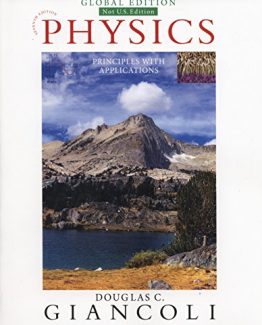Advanced Physics For You 2nd Edition by John Miller, ISBN-13: 978-1408527375
[PDF eBook eTextbook]
- Publisher: Nelson Thornes Ltd (January 1, 2015)
- Language: English
- 515 pages (Large File Size: 62 MB)
- ISBN-10: 1408527375
- ISBN-13: 978-1408527375
From the same author as the popular first edition, the second edition of this trusted, accessible physics textbook breaks down content into manageable chunks to help students with the transition from GCSE to A Level study. It has been fully revised and updated for the new A Level specifications for first teaching from September 2015, and is suitable for AQA, OCR, WJEC and Edexcel. The textbook provides plenty of examples and practice questions for consolidation of learning. Additional sections in the textbook provide help with revision and exam technique, practical skills and maths skills.
Table of Contents:
Title Page
Contents
1 Basic Ideas
Homogeneity of equations
The importance of significant figures
Vectors and scalars
Vector addition
Combining perpendicular vectors
Vector subtraction
Combining vectors using scale drawing
Resolving vectors
Combining non-perpendicular vectors by calculation
Summary
2 Looking at Forces
Electromagnetic forces
‘Normal’ contact forces
Tension
Friction between solid surfaces
Fluid resistance (drag)
Stokes’ Law
Lift
Free-body force diagrams
Pressure
Upthrust
Floating and sinking
Physics at work: Automotive forces
Summary
3 Turning Effects of Forces
Calculating moments
Principle of moments
Centre of gravity (centre of mass)
Solving equilibrium problems
Questions
4 Describing Motion
Displacement–time graphs
Velocity–time graphs
Equations of motion
Vertical motion under gravity
Terminal velocity
Projectiles
Effect of friction on projectiles
5 Newton’s Laws and Momentum
Newton’s First Law
Inertia
Momentum
Newton’s Second Law
Newton’s Third Law
Newton’s Laws : More worked examples
Impulse
Conservation of momentum
Conservation of momentum in two dimensions
Physics at work : Car safety
Summary
Questions
6 Work, Energy and Power
Power
Types of energy
Interchange between KE and PE
Conservation of energy
Efficiency
Elastic and inelastic collisions
Summary
Questions
7 Circular Motion
Measuring rotation
Centripetal acceleration
Centripetal force
Moving in horizontal circles
Moving in vertical circles
Physics at work : Bobsleigh bends
Derivation of the centripetal acceleration formula
Summary
Questions
8 Gravitational Forces and Fields
Gravitational force
Gravitational field
Satellites
Gravitational potential, V
Kepler’s Laws of Planetary Motion
Physics at work : Satellites and space probes
Summary
Questions
9 Simple Harmonic Motion
Graphs of SHM
Equations for SHM
The simple pendulum
A mass on a spring
Energy in SHM
Damping
Resonance
Physics at work : Oscillations and resonance
Summary
Questions
Basic Ideas
Looking at Forces
Turning Effects of Forces
Describing Motion
Newton’s Laws and Momentum
Work, Energy and Power
Circular Motion
Gravitational Forces and Fields
Simple Harmonic Motion
Synoptic Questions on Mechanics
10 Wave Motion
Wavelength 𝛌
Period
The wave equation
Energy transferred by waves
Waves spreading through space
Phase
Transverse and longitudinal
Electromagnetic waves
The regions of the electromagnetic spectrum
The nature of electromagnetic radiation
Measuring the speed of light
Polarisation
Polarisation of radio waves
Transverse or longitudinal
The Physics of hearing
What is a decibel ?
Human perception of loudness
Defects of hearing
Physics at work : Earthquakes and Tsunamis
Summary
Questions
11 Reflection and Refraction
Refraction and a change in speed
Snell’s Law
Refractive index n and the speed of light
Critical angle and refractive index
Total internal reflection
Optical fibres
Physics at work : Using refraction and reflection
Lenses
Forming images with lenses
Magnification
The astronomical refracting telescope
Aberrations in lenses
The eye
Defects of vision
Physics at work : Reflecting telescopes
Physics at work : Reflecting telescopes
Summary
12 Interference and Diffraction
Stationary or standing waves
Standing waves and resonance
Stationary waves in wind instruments
Physics at work: Standing waves
Physics at work : Hertz discovers radio waves
Diffraction
Physics at work : Hertz discovers radio waves
Diffraction
Resolution
Physics at work: Diffraction
Two-source interference
Two-source interference of light
Young’s double-slit experiment
Physics at work: Interference
Diffraction grating
Summary
Wave Motion
Reflection and Refraction
Interference and Diffraction
Synoptic Questions on Waves
13 Materials
Stretching materials
Elastic potential energy
Properties of materials
Stress
Strain
The Young modulus
Measuring the Young modulus for steel
Stress–strain graphs for different metals
Yielding and breaking
Polymers
Faults in crystals
Tension and compression
Physics at work : Composite materials
Summary
14 Thermodynamics
The 1st Law of Thermodynamics
The Celsius temperature scale
Absolute zero and the Kelvin temperature scale
Internal energy and atomic movement
Specific latent heat
Specific heat capacity
Physics at work
Physics at work
Summary
Questions
15 Gases and Kinetic Theory
Boyle’s Law
Heating and cooling a gas
The Avogadro constant and the mole
The ideal gas equation
Kinetic theory
Kinetic energy and the Boltzmann constant, k
Physics at work : Liquefying helium
Physics at work : Gases
Summary
Materials
Gases and Kinetic Theory
16 Current and Charge
Electric currents
Energy transfer and potential difference
Resistance
Resistivity
Current–voltage characteristics
Electrical power
Power in the home
Physics at work : Using electricity
Physics at work : Using electricity
Physics at work : Biopotentials
Physics at work : The electrocardiogram (ECG)
Summary
Questions
17 Electric Circuits
Energy transfer in a series circuit
Energy transfer in a parallel circuit
Resistors in series
Resistors in parallel
The potential divider (voltage divider)
Variable resistors
Electromotive force
Kirchhoff’s Second Law
The circuit equation
Solving circuit problems
Physics at work: Current, voltage, resistance
Summary
Questions
18 Magnetic Fields
Magnetic fields
The magnetic effect of a current
Magnetic materials
Measuring magnetic flux density
Magnetic force
The magnetic force on a moving charge
Circular paths
Forces between currents
Physics at work : Magnetic fields
Summary
19 Electromagnetic Induction
Electromagnetic induction using two coils
Magnetic flux
Faraday’s Law
Lenz’s Law
The a.c. generator
Physics at work : Using electromagnetic induction
Summary
Questions
20 Alternating Current
Root-mean-square (r.m.s.) values
The cathode-ray oscilloscope (CRO)
Using the oscilloscope
The transformer
Rectification
Summary
Questions
21 Electric Fields
Forces between charges
Another inverse-square law
Electric fields
Electric potential
Physics at work : Using static electricity
Summary
Questions
22 Capacitors
Charging and discharging a capacitor
Capacitance
The energy of a charged capacitor
Capacitors in parallel
Capacitors in series
Discharging a capacitor
Charging a capacitor : Exponential growth
Physics at work : Capacitors
Physics at work : Designing practical capacitors
Summary
Questions
Current and Charge
Magnetic Fields
Electromagnetic Induction
Electric Fields
Capacitors
The CRO and a.c.
Synoptic Questions on Electricity
23 Electrons and Photons
Electron beams
Electron kinetic energy and the electron-volt (e V )
Thomson’s measurement of Qm for electron
Physics at work : Particle accelerators
Millikan’s experiment to measure electron charge
Using light to free electrons
The photoelectric effect
Physics at work : Corpuscles and waves
Planck’s equation and photon energy
Escaping from a metal : The work function
Einstein’s photoelectric equation
Measuring the Planck constant
Physics at work : Photons and electrons
Electrons as waves
De Broglie’s equation
Electron waves and the atom
Physics at work : Modern microscopes
Summary
Questions
24 Spectra and Energy Levels
Heat radiation
Black bodies
The luminosity of stars
Physics at work : Electromagnetic waves
Coloured spectra
The hydrogen spectrum
Energy levels and quanta
The energy levels of hydrogen
Absorption spectra
Stimulated emission
Physics at work : Fluorescence
Physics at work : Emission and absorption in Chemistry
Summary
Questions
Electrons and Photons
Spectra and Energy Levels
25 Radioactivity
The structure of the atom
Radioactivity
Detecting radioactivity
Alpha, beta and gamma radiation
How is radiation absorbed ?
Why is radiation dangerous ?
The inverse-square law for gamma radiation
Radioactive decay
Nuclear stability
The random nature of radioactive decay
The decay constant
Exponential decay
Physics at work : Investigating the atom
Physics at work : Radioactive dating
Physics at work : Radiotherapy
Summary
Questions
26 Nuclear Energy
A famous equation
Binding energy
Fission
Fusion
Nuclear power stations
Physics at work : Nuclear issues
Summary
27 Particle Physics
Fundamental particles
Inside the hadrons
Quark properties and conservation laws
Fundamental forces and exchange particles
Feynman diagrams
Physics at work : Particle physics
Summary
Questions
Radioactivity
The Nuclear Model of the Atom
Nuclear Energy
Particle Physics
Further Questions on Nuclear Physics
28 Special Relativity
The Michelson–Morley experiment
Einstein’s postulates
Time dilation
Muon decay
Length contraction
Relativistic mass
Mass and energy
Summary
Questions
29 Astrophysics
Observing the sky
Measuring distances
Classifying stars : how bright are they ?
Classifying stars : how hot are they ?
The Hertzsprung–Russell (HR) diagram
The Doppler effect
Hubble’s Law
Physics at work : Dark matter and dark energy
Physics at work : Supermassive black holes
Physics at work : Quasars
Physics at work : Neutron stars
Physics at work : Black holes
Support for the Big Bang theory
Physics at work : Exoplanets
Questions
30 Medical Imaging Techniques
The X-ray machine
The X-ray spectrum
Interaction of X-rays with matter
Attenuation processes
Radiography
Advances in X-ray imaging
Radioactive medical tracers
The gamma camera
Obtaining radioactive tracers
Positron emission tomography (PET)
Ultrasound imaging
Ultrasound : acoustic impedance
The ultrasound transducer
Doppler ultrasound
Magnetic resonance imaging (MRI)
The MRI scanner
Summary
Questions
Special Relativity
Astrophysics
Medical Physics
More questions on Modern Physics
Synoptic Questions for A2
Study Skills
Becoming more confident with Maths
How to tackle mathematical homework questions
Revision skills
Eight revision techniques
Organising your revision
Examination technique
Doing Your Practical Work
Implementing
Analysing evidence and drawing conclusions
Evaluation of procedures and results
Dealing with errors and uncertainty
Calculations involving uncertainties
Check Your Maths
Powers
Geometry and Trigonometry
Plotting graphs
Graphs and the area beneath a line
The equation of a straight-line graph
Some common graph shapes
Direct proportion
Equations
Simultaneous equations
Using Spreadsheets
Modelling behaviour
Analysis of data
Simulations
Exponentials
Worked example : Using logarithmic graphs and a spreadsheet
Hints and Answers
Further Questions on Mechanics
Waves
Matter and Molecules
Further Questions: Matter and Molecules
Electricity
Nuclear Physics
Further Questions on Quantum Physics
Further Questions on Nuclear Physics
Modern Physics
Further Questions on Modern Physics
Synoptic Questions for A2
Index
Back Cover
What makes us different?
• Instant Download
• Always Competitive Pricing
• 100% Privacy
• FREE Sample Available
• 24-7 LIVE Customer Support





